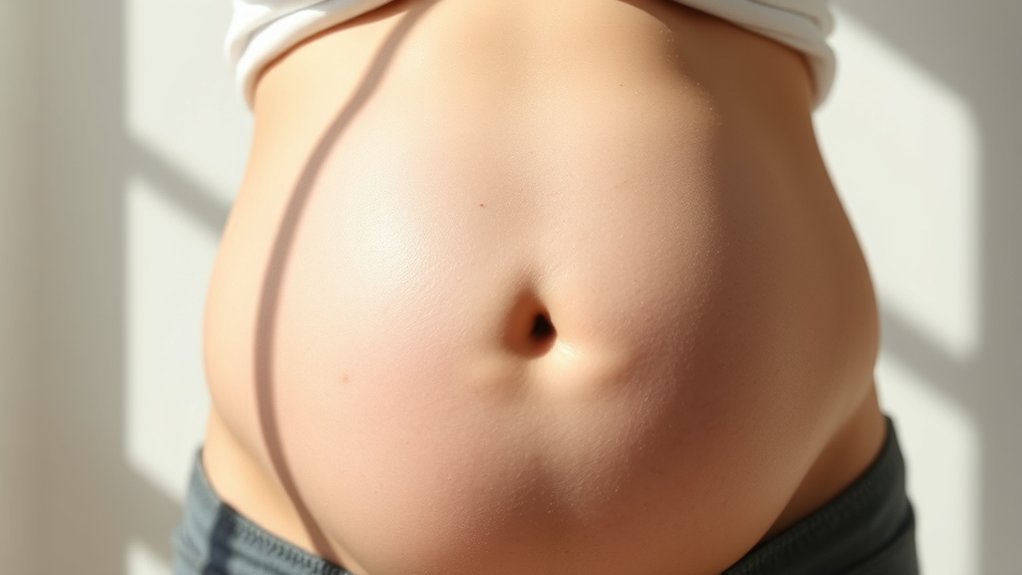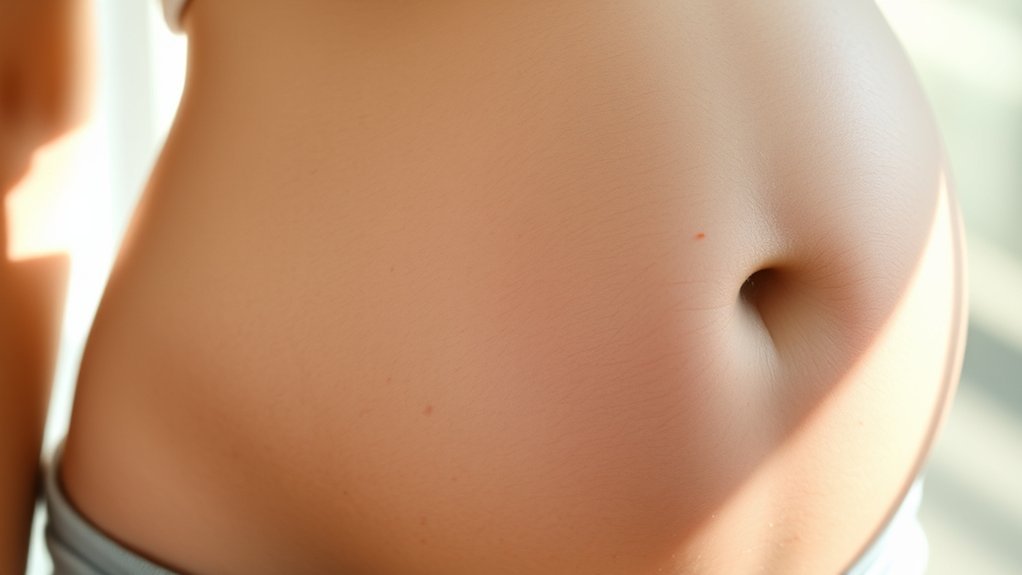If you’ve recently noticed a gap in your abdominal muscles, you’re not alone—many experience this after pregnancy or significant weight changes. Understanding Diastasis Recti is essential for regaining core strength and overall health. You might be wondering about its causes, how to identify it at home, and effective management strategies. Let’s explore the nuances of this condition and what you can do to address it effectively.
What Is Diastasis Recti?
Diastasis recti, often referred to as “ab separation,” is a condition where the left and right halves of your rectus abdominis muscles separate, creating a gap along the midline of your abdomen.
Diastasis recti is a condition characterized by the separation of the rectus abdominis muscles, resulting in a gap along the abdomen.
This condition affects approximately 60% of women postpartum, but it can also occur in men and individuals with rapid weight changes. The excessive inner-abdominal pressure, particularly during pregnancy, stretches the linea alba connective tissue, leading to symptoms like a visible bulge and core weakness.
Evaluating the gap between your abdominal muscles can help determine if you have diastasis recti; a gap of more than two finger widths signals potential issues.
Engaging in core exercises and seeking physical therapy can aid in recovery and restoration of abdominal strength.
What Causes Diastasis Recti?
One of the primary causes of diastasis recti is the excessive inner-abdominal pressure created during pregnancy, as the growing uterus pushes against the abdominal muscles and stretches the linea alba.
Hormonal changes during this time weaken the connective tissue, making it more susceptible to separation. Risk factors include multiple pregnancies, delivering larger babies, being over 35, and cesarean deliveries.
In men, chronic straining from improper exercise techniques or excessive weight lifting can also contribute to the condition.
Additionally, rapid weight gain or loss, constipation-related straining, and age-related loss of elasticity in the abdominal wall can increase the likelihood of developing diastasis recti.
Consulting a physical therapist can help address these issues effectively and promote healing postpartum.
How to Identify Diastasis Recti at Home
How can you tell if you have diastasis recti at home?
Start by lying on your back with your knees bent. Lift your head slightly and use your fingers to check for a gap between your abdominal muscles. If you feel a gap of more than two finger widths (about 2 cm) above, at, or below your belly button, you may have diastasis recti.
Lie on your back, lift your head, and check for a gap in your abdominal muscles to assess for diastasis recti.
Additionally, observe for any bulging in your abdomen when you tense your abdominal muscles during movements like crunches or leg lifts. Look for a deep valley or tenting appearance when applying pressure during core exercises.
If you experience discomfort or persistent separation, consult a healthcare professional for a thorough assessment.
Symptoms of Diastasis Recti

Recognizing diastasis recti involves not only identifying the physical separation of the abdominal muscles but also being aware of the various symptoms that may accompany this condition.
You might notice a visible bulge or “pooch” near your belly button, especially when you engage your abdominal muscles. The “doming” effect can also occur during movements like crunches, where your abdomen protrudes into a tent-like shape.
Additionally, you may feel discomfort or a soft, jelly-like sensation around your midsection when activating your core. Some individuals experience low back pain due to weak abdominal muscles, while others may feel self-conscious about their body image.
Symptoms can develop weeks or months post-childbirth and may persist if untreated, affecting your overall well-being.
How to Manage and Treat Diastasis Recti
Managing and treating diastasis recti requires a thoughtful approach that focuses on strengthening your abdominal muscles and minimizing pressure on the abdominal wall.
A mindful approach to strengthening your abdominal muscles is essential for effectively managing diastasis recti.
To heal diastasis recti effectively, consider incorporating these strategies into your treatment plan:
- Engage your deep core muscles by drawing your belly button towards your spine.
- Focus on gentle exercises that strengthen your pelvic floor muscle.
- Avoid heavy lifting and activities that may exacerbate the abdominal gap.
- Always lift and move by bending back with your knees to reduce strain.
Early intervention postpartum can lead to better outcomes, so stay proactive in your rehabilitation.
When to Seek Professional Help
When should you consider reaching out for professional help regarding diastasis recti?
If you notice a gap of more than two finger widths in your abdominal muscles, it’s time to consult a healthcare provider for evaluation.
Persistent lower back pain or pelvic pain may indicate complications linked to diastasis recti, warranting professional assessment.
If you’re struggling with daily activities, like lifting or walking due to abdominal weakness, you should seek help.
Additionally, if you experience urinary incontinence or bowel dysfunction four months postpartum, these issues may relate to diastasis recti.
Finally, if you don’t see noticeable improvement in core strength or muscle separation within six months of dedicated exercises, professional guidance is essential for healing your abdominal wall effectively.
How to Prevent Diastasis Recti

Preventing diastasis recti requires proactive measures during pregnancy and beyond.
As a pregnant woman, focusing on your belly and core can greatly reduce your risk.
Here are some effective strategies to reflect on:
- Engage in core-strengthening exercises, including pelvic floor exercises.
- Maintain good posture while lifting and during daily activities.
- Avoid activities that increase intra-abdominal pressure, like heavy lifting or intense abdominal workouts.
- Stay active with low-impact exercises, such as walking or swimming.
Can Men Experience Diastasis Recti?
Yes, men can experience diastasis recti, often due to excessive straining from activities like heavy lifting or rapid weight gain.
You might notice symptoms such as a visible bulge in your abdomen during core engagement, along with potential discomfort or weakness.
Understanding the causes and seeking a professional evaluation is essential to address this condition effectively.
Causes in Men
Although diastasis recti is often associated with women, men can also experience this condition, primarily due to excessive inner-abdominal pressure.
Factors contributing to abdominal separation in men include:
- Heavy weightlifting
- Rapid weight gain or obesity
- Chronic straining during activities
- Certain surgical procedures
These elements can lead to a protruding belly appearance, physical discomfort, and complications similar to those seen in women.
You may also experience low back pain, poor posture, and reduced core stability.
While it’s less common for men, if you suspect you have diastasis recti, it’s essential to consult healthcare professionals for proper diagnosis and management.
Addressing these issues early on can help restore core strength and overall health.
Symptoms and Diagnosis
When experiencing diastasis recti, men might notice several symptoms that can considerably impact their daily lives. You may observe a visible bulge in your abdomen, particularly during activities that increase core pressure, like lifting or straining.
Diagnosis can be done through self-assessment; if you can fit two fingers or more in the gap between your rectus abdominis muscles, it indicates the presence of this common condition.
Alongside the bulge, you might feel discomfort or weakness in your abdominal area. Unfortunately, stigma may prevent you from seeking help.
However, early intervention through a targeted exercise program and consultation with healthcare professionals can help manage and potentially heal diastasis recti effectively.
Frequently Asked Questions
What Should You Not Do With Diastasis Recti?
You shouldn’t perform traditional crunches, heavy lifting, or high-impact exercises with diastasis recti. Avoid movements that cause your abdominal muscles to bulge, and don’t rely solely on abdominal binders for support or healing.
Can Diastasis Recti Cause Heartburn?
When it comes to diastasis recti, you might find it can indeed cause heartburn. The separation can increase pressure in your abdomen, pushing stomach contents upwards and triggering uncomfortable symptoms like acid reflux.
What Is the Fastest Way to Heal Diastasis Recti?
To heal diastasis recti quickly, focus on consistent core strengthening exercises and deep core activation techniques. Avoid high-pressure activities, and consider working with a physical therapist to tailor a safe, effective recovery plan for yourself.
What Do You Need to Know About Diastasis Recti?
If you’re struggling with a persistent belly bulge post-pregnancy, know that diastasis recti can affect anyone. Understanding its causes, symptoms, and effective treatment options empowers you to regain core strength and confidence.
Conclusion
In maneuvering the journey of Diastasis Recti, consider your body a vessel, weathered yet resilient. Just as a ship may need repairs after a storm, your core can heal with the right care and attention. By understanding the condition and seeking appropriate management, you’re not only restoring strength but also nurturing your overall well-being. Embrace the process, and remember: every ripple of progress contributes to the stability of your foundation, guiding you toward a healthier future.
